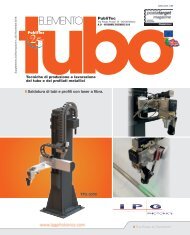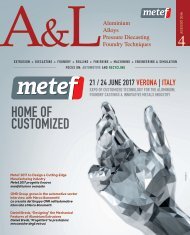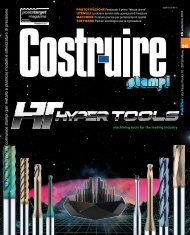Sfogliabile_Applicazioni_Laser_maggio_57
Create successful ePaper yourself
Turn your PDF publications into a flip-book with our unique Google optimized e-Paper software.
The<br />
Journal<br />
additive<br />
in netfabb è preSente l’innovativa tecnologia<br />
di controllo di project eScher, per<br />
potenziare le macchine con teStine di Stampa<br />
multiple baSate Sull’eStruSione che lavorano<br />
inSieme per Stampare una Singola parte.<br />
Netfabb iNcludes the iNNovative coNtrol<br />
techNology by project escher, to eNhaNce<br />
machiNes with multiple priNtiNg heads based<br />
oN extrusioN which work together to priNt<br />
a siNgle part.<br />
nostri clienti comuni un’esperienza di stampa di produzione<br />
additiva ottimizzata”, ha commentato Stephen<br />
Anderson, Renishaw Software Director.<br />
“Siamo certi che ci saranno future opportunità di integrazione<br />
con QuantAM - una serie di API che possono essere<br />
messe a disposizione di coloro che vogliono sfruttare<br />
la potenza della piattaforma per la produzione additiva<br />
Renishaw. Ciò garantirà agli utenti di Autodesk Netfabb<br />
che i percorsi utensile da loro generati siano ottimizzati<br />
per i sistemi AM di Renishaw, garantendo la massima<br />
qualità dei pezzi”.<br />
“Netfabb permette di accelerare i processi di progettazione<br />
e generazione nella produzione additiva, fornendo<br />
a progettisti e ingegneri gli strumenti necessari per<br />
produrre al meglio le parti, ottimizzare i workflow e migliorare<br />
l’efficienza delle loro stampanti grazie a un’unica<br />
soluzione software”, ha dichiarato Mark Forth,<br />
Manager of Manufacturing Industry Strategy di Autodesk.<br />
“L’introduzione della simulazione basata su cloud,<br />
di funzionalità di workflow sottrattivi e di stampa 3D<br />
collaborativa significa fornire ai clienti la più potente e<br />
completa soluzione additiva disponibile sul mercato”. yyy<br />
eling instruments aligned to the CAM workflow. Besides, it<br />
allows manufacturers to keep an eye on the original solid<br />
model and monitor with ease the near-net form, created<br />
purposely to enable subtractive processes. By means of a<br />
greater visibility of the original model and of the nearnet<br />
shape feature, Netfabb opens up a connected workflow<br />
between preparatory construction and post-processing activities.<br />
multi-head Collaborative 3d printing<br />
This important update includes the innovative control<br />
technology by Project Escher, to enhance machines with<br />
multiple printing heads based on extrusion which work<br />
together to print a single part. This collaborative process<br />
enables a more detailed and faster printing of 3D parts at<br />
industrial level.<br />
In conformity with the objective of bringing innovation<br />
to the additive sector, Autodesk makes available in open<br />
source mode the hardware and software specifications<br />
needed to create machines with this new collaborative<br />
multi-head 3D printing feature.<br />
In this way, hardware vendors may create multi-head<br />
printers which can print parts much faster than traditional<br />
single head printers.<br />
a unique software solution<br />
“New production, optimization and simulation tools integrated<br />
into Netfabb are very interesting and we are pleased<br />
to cooperate with Autodesk to provide our common clients<br />
with an optimized additive production printing experience”,<br />
Stephen Anderson, Renishaw Software Director, remarked.<br />
“We are convinced that there will be future integration<br />
opportunities with QuantAM - a series of APIs<br />
which may be made available for those wishing to develop<br />
the potential of the Renishaw platform for additive production.<br />
This will ensure that utensil pathways generated by Autodesk<br />
Netfabb users will be optimized for Renishaw’s AM systems,<br />
guaranteeing the highest quality for the items”.“Netfabb<br />
allows an acceleration of the design and generation processes<br />
in additive manufacturing, providing designers and<br />
engineers with the tools required to produce the parts in<br />
the best possible way, to optimize workflow and to improve<br />
the efficiency of their printers thanks to a unique software<br />
solution” Mark Forth, Manager of Manufacturing Industry<br />
Strategy, Autodesk, declared. “The introduction of cloudbased<br />
simulation, of subtractive workflow functions and of<br />
collaborative 3D printing imply providing clients with the<br />
most complete and powerful additive solution available on<br />
the market”. yyy<br />
58 <strong>maggio</strong> giugno 2017 The Additive Journal





